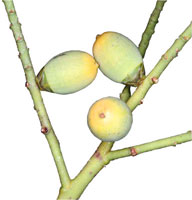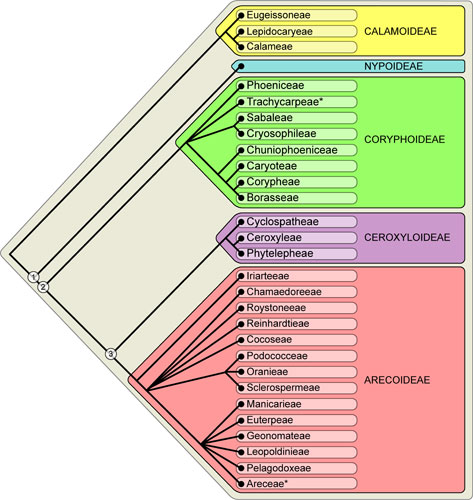- Acanthophoenix
- Acrocomia
- Actinokentia
- Actinorhytis
- Adonidia
- Aiphanes
- Allagoptera
- Ammandra
- Aphandra
- Archontophoenix
- Areca
- Arenga
- Asterogyne
- Astrocaryum
- Attalea
- Bactris
- Balaka
- Barcella
- Basselinia
- Beccariophoenix
- Bismarckia
- Borassodendron
- Borassus
- Brassiophoenix
- Burretiokentia
- Butia
- Calamus
- Calyptrocalyx
- Calyptrogyne
- Calyptronoma
- Carpentaria
- Carpoxylon
- Caryota
- Ceratolobus
- Ceroxylon
- Chamaedorea
- Chamaerops
- Chambeyronia
- Chelyocarpus
- Chuniophoenix
- Clinosperma
- Coccothrinax
- Cocos
- Corypha
- Cryosophila
- Cyphokentia
- Cyphophoenix
- Cyphosperma
- Daemonorops
- Deckenia
- Desmoncus
- Dictyocaryum
- Drymophloeus
- Dypsis
- Elaeis
- Eleiodoxa
- Eremospatha
- Eugeissona
- Euterpe
- Gaussia
- Geonoma
- Guihaia
- Hedyscepe
- Hemithrinax
- Howea
- Hyophorbe
- Hyospathe
- Hyphaene
- Iriartea
- Iriartella
- Itaya
- Jailoloa
- Johannesteijsmannia
- Juania
- Jubaea
- Jubaeopsis
- Kentiopsis
- Kerriodoxa
- Korthalsia
- Laccospadix
- Laccosperma
- Lanonia
- Latania
- Lemurophoenix
- Leopoldinia
- Lepidocaryum
- Lepidorrhachis
- Leucothrinax
- Licuala
- Linospadix
- Livistona
- Lodoicea
- Lytocaryum
- Manicaria
- Manjekia
- Marojejya
- Masoala
- Mauritia
- Mauritiella
- Maxburretia
- Medemia
- Metroxylon
- Myrialepis
- Nannorrhops
- Nenga
- Neonicholsonia
- Neoveitchia
- Nephrosperma
- Normanbya
- Nypa
- Oenocarpus
- Oncocalamus
- Oncosperma
- Orania
- Oraniopsis
- Parajubaea
- Pelagodoxa
- Phoenicophorium
- Phoenix
- Pholidocarpus
- Pholidostachys
- Physokentia
- Phytelephas
- Pigafetta
- Pinanga
- Plectocomia
- Plectocomiopsis
- Podococcus
- Pogonotium
- Ponapea
- Prestoea
- Pseudophoenix
- Ptychococcus
- Ptychosperma
- Raphia
- Ravenea
- Reinhardtia
- Retispatha
- Rhapidophyllum
- Rhapis
- Rhopalostylis
- Roscheria
- Roystonea
- Sabal
- Sabinaria
- Salacca
- Saribus
- Satakentia
- Satranala
- Schippia
- Sclerosperma
- Socratea
- Solfia
- Sommieria
- Syagrus
- Synechanthus
- Tahina
- Tectiphiala
- Thrinax
- Trachycarpus
- Trithrinax
- Veitchia
- Verschaffeltia
- Voanioala
- Wallaceodoxa
- Wallichia
- Welfia
- Wendlandiella
- Wettinia
- Wodyetia
- Zombia
- x Jubautia splendens
- ?? Acoelorrhaphe
- ?? Bentinckia
- ?? Brahea
- ?? Clinostigma
- ?? Colpothrinax
- ?? Copernicia
- ?? Cyrtostachys
- ?? Dictyosperma
- ?? Dransfieldia
- ?? Heterospathe
- ?? Hydriastele
- ?? Iguanura
- ?? Incertae sedis & excluded names
- ?? Loxococcus
- ?? Micronoma
- ?? Paripon
- ?? Pritchardia
- ?? Rhopaloblaste
- ?? Serenoa
- ?? Washingtonia
About Palms: Phylogeny
Introduction
Classification
Phylogeny
Phylogeny
 Phylogenetics is the part of the broader field of systematics that focuses on the evolutionary relationships between organisms. Modern phylogenetic studies have superseded earlier studies of evolutionary relationships because they are based on explicit analyses of clearly formulated datasets of characters (e.g. morphology, DNA) rather than on subjective interpretations. Phylogenetic analyses yield phylogenetic trees (also termed phylogenies), which are dichotomously branching diagrams that are sometimes likened to a family tree or a ‘tree of life’. The point of divergence between two branches is termed a node and is taken to represent a hypothesis of shared ancestry of the resultant lineages. Phylogenetic trees can be used to test existing classifications and to build new ones, but they also have far-reaching implications beyond systematics, underpinning comparative and evolutionary biology as well as much applied research, for example, in human health and agriculture.
Phylogenetics is the part of the broader field of systematics that focuses on the evolutionary relationships between organisms. Modern phylogenetic studies have superseded earlier studies of evolutionary relationships because they are based on explicit analyses of clearly formulated datasets of characters (e.g. morphology, DNA) rather than on subjective interpretations. Phylogenetic analyses yield phylogenetic trees (also termed phylogenies), which are dichotomously branching diagrams that are sometimes likened to a family tree or a ‘tree of life’. The point of divergence between two branches is termed a node and is taken to represent a hypothesis of shared ancestry of the resultant lineages. Phylogenetic trees can be used to test existing classifications and to build new ones, but they also have far-reaching implications beyond systematics, underpinning comparative and evolutionary biology as well as much applied research, for example, in human health and agriculture.
Palms have been the focus of numerous phylogenetic studies, commencing in 1990. Due to the advent of DNA-based methods, major advances have now been made that give us an increasingly robust picture of the relationships among palms. The figure given here gives a summary of relationships among the tribes and subfamilies of palms. A more detailed picture can be obtained from a phylogeny of all palm genera published by Baker et al. (2009) .

William J. Baker, Vincent Savolainen, Conny B. Asmussen-Lange, Mark W. Chase, John Dransfield, Félix Forest, Madeline M. Harley, Natalie W. Uhl, and Mark Wilkinson. Complete Generic-Level Phylogenetic Analyses of Palms (Arecaceae) with Comparisons of Supertree and Supermatrix Approaches. Syst Biol 2009 58: 240-256. PDF (subscription required)

